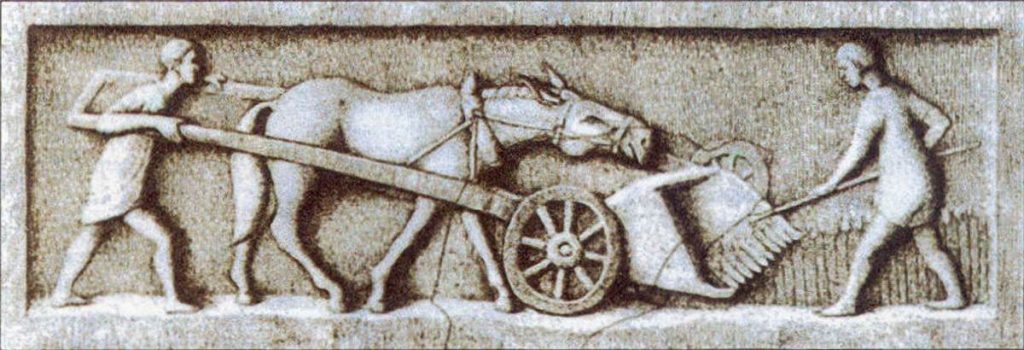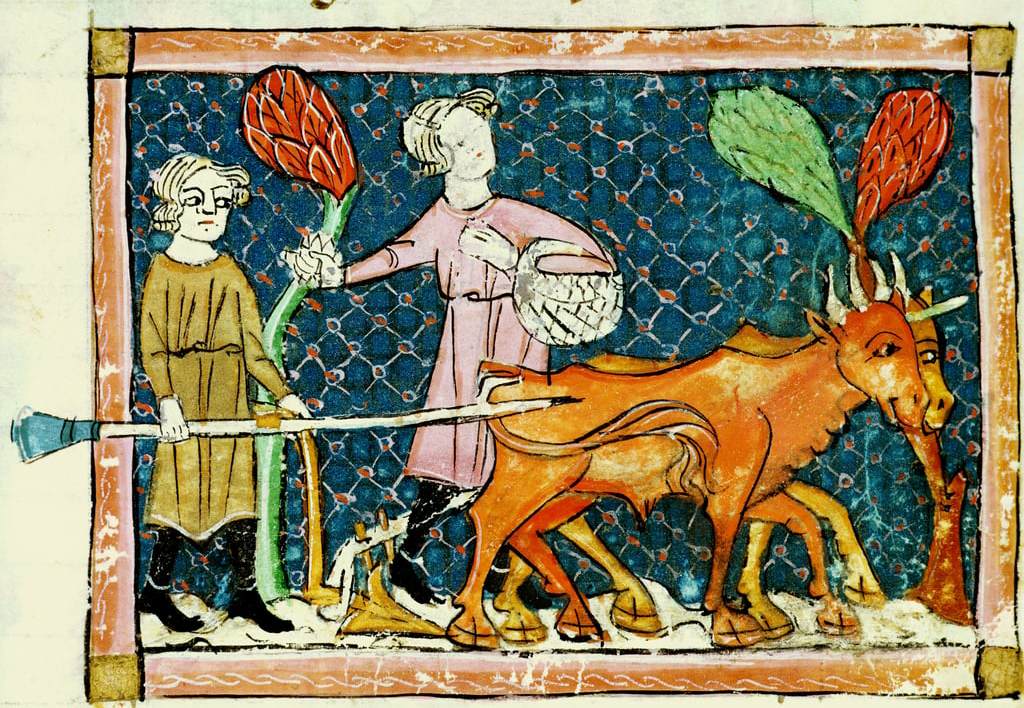An overview of the reasons for following crop rotation and the history of crop rotation. Once you understand the principles of crop rotation the various systems and the theories behind those systems start to make sense.
Why follow Crop Rotation?
If you grow the same crop in the same place year after year you will get a build up of pests and diseases specific to that crop. Different crops take different levels of nutrients from the soil and inevitably these become unbalanced, exhausting one nutrient but leaving a lot of another. This is often referred to as a ‘sick soil’. Even the addition of fertilizers is unlikely to help since it is likely the trace elements and micro-nutrients are depleted in the same way.
Some gardeners persist in growing their runner beans or onions in the same place each year but it has been proven this is not a good idea – not every old fashioned method is good!
Rotating crops will reduce losses to pest and disease. Combine this with bettter use of nutrients and you will find increased yields from the same area of land.
What is Crop Rotation?
A basic principle of crop rotation is not to grow the same thing in the same place two years running. In fact, the larger the gap between a crop occupying the same piece of ground the better. Some pests may be present at high levels initially but a gap of three or four years will see their numbers fall to acceptable levels without a host to sustain them.
There are many different systems for rotating crops, some fairly crude and some quite complex, designed to ensure that following crops utilise nutrients left by previous crops. The simplest is a three year crop rotation but a four year crop rotation plan or even a five year crop rotation may suit you better. I have seen eight and ten year crop rotation plans but these are probably too complex for gardeners.
Who Invented Crop Rotation and When?
The concept of crop rotation goes into prehistory so answering the question of who invented crop rotation and when is not easy. Still, a little background over the last couple of thousand years.
The Romans

Roman Farming –
Roman harvesting machine from Trier (Germany), a city of the Roman province Gallia Belgica
The Romans were known for their advanced agricultural practices, and crop rotation was one of the methods they used to improve the yield of their crops. They would plant legumes such as beans, peas, and lentils in one season, and then plant grains such as wheat, barley, and rye in the next season.
The legumes helped to fix nitrogen in the soil, which is an essential nutrient for plant growth. By rotating legumes with grain crops, the soil would become enriched with nitrogen, making it more fertile and productive. This practice was an important part of Roman agriculture and helped to sustain their growing population.
There are several ancient sources that mention the Roman practice of crop rotation. Cato the Elder, who lived in the 2nd century BC, wrote a treatise on agriculture called De Agri Cultura, in which he describes the benefits of crop rotation. He writes, “I praise a two-field system, where one field is planted and one lies fallow. But it is even better to have three fields, so that in addition to one field lying fallow, another is sown and the third is harvested.”
In the 1st century BC, Varro wrote about crop rotation in his work Rerum Rusticarum. He recommended a three-field system, where one field was sown with a cereal crop, one with a legume crop, and one was left fallow.
200 years later in the 1st century AD, Pliny the Elder mentions crop rotation in his work Naturalis Historia. He writes, “It is better to divide the land into three parts, so that one may be sown with a winter crop, another with a summer crop, and the third may lie fallow.”
Medieval Crop Rotation in Europe
Following the turmoil after the departure of the Romans from Britain and the collapse of the Roman Empire populations crashed and agricultural declined. Once populations began to recover agriculture developed to meet the need. The medieval farmers used a three-field crop rotation system. This, along with other innovations such as the mould board plough which replaced the scratch plough enabled increases in productivity.
This method involved dividing a field into three sections and rotating the crops grown in each section every year. The three sections were typically planted with winter wheat or rye, spring oats or barley, and a fallow field that was left unplanted. The crops were rotated each year so that the field that had been left fallow in the previous year would be planted with a crop the following year.
During the fallow period, farmers would often allow their sheep or cattle to graze on the field. The animals would eat the weeds and other unwanted plants, which helped to prepare the field for the next year’s crop. In addition, their manure would fertilize the soil, providing nutrients that would help to improve the yield of the following year’s crop.
In some cases, farmers would use a four-field rotation system that included a dedicated pasture for livestock. This pasture would be used to graze sheep or cattle during the growing season, which would prevent overgrazing on the other fields and help to maintain soil fertility.
Overall, the use of livestock in the medieval crop rotation system helped to maintain soil fertility and increase crop yields, making it an essential component of European agriculture
Crop Rotation in 17th & 18th Centuries
In the 17th and 18th centuries, European farmers continued to practice crop rotation as a way of improving soil fertility and increasing crop yields. However, there were some changes in the specific crops that were grown and the rotation patterns that were used.
One of the most significant changes was the introduction of new crops from the Americas, such as maize (corn) and potatoes. These crops were highly productive and could be grown in areas where traditional European crops like wheat and barley did not thrive. As a result, farmers began to incorporate these new crops into their rotation patterns, often replacing fallow fields with crops like potatoes or maize.
Another change in crop rotation patterns during this period was the use of longer rotations. Some farmers began to adopt a four- or five-field rotation, in which crops were rotated between four or five sections of a field over a longer period of time. This allowed for greater diversity in crops and helped to prevent soil nutrient depletion.
Turnip Townshend
These four year systems did away with a fallow year. Known as the Norfolk System although it was developed in Belgium in the early 16th Century, it was promoted in Britain by Charles Townshend, Viscount in the 1700’s. Because of the turnips in the rotation (wheat, turnips, barley and clover) he acquired the nickname of Turnip Townshend
George Washington
Over in the USA, George Washington Carver was instrumental in introducing crop rotation into the southern states where the monoculture permanent growth of cotton was depleting the soil and increasing pest populations.
By rotating with peanuts and sweet potatoes he provided the means for growing alternative cash crops and increasing yields of all crops.
1950’s Organic Fertility Farming
By 1951 in Britain, Newman Turner was promoting an eight course crop rotation for organic farmers in his book Fertility Farming. Although out of print and hard to obtain you can read it online here
Home Growers – Simplicity Helps!
For the home vegetable grower, complex rotations are hard to manage but a simple 3 course crop rotation is usually adequate. Sometime, a four course crop rotation or even a five course crop rotation can be used. Beyond this level most growers will be unable to control what’s going where.
The Three Course Rotation was the system taught to novice gardeners via the Dig for Victory campaign of WW2 and it’s influence remains today.
Some crops really sit outside of the crop rotation. Those in permanent beds such as rhubarb, comfrey and asparagus obviously do not need to be considered and some crops do not easily fit in like cucurbits – the cucumber family that includes pumpkins, marrows and squashes.
Not all Crops Rotate
These do have their place though, filling in where a crop does not fill its assigned space in the rotation. Even with these crops it is a good idea not to grow them in the same place two years running if it can be avoided.
General crop rotation plans are fine but what if you do not like onions and garlic? Or you only have a small plot and don’t bother with maincrop potatoes? Then you need to plan your own rotation following the basic principles of crop rotation.
Principles of Crop Rotation
- The first principle of any crop rotation is to have the largest possible gap between potatoes occupying the same piece of ground. The same applies for brassicas, the cabbage family.
- Keep lime away from potatoes because it increases the chances of them getting scab. Conversely, brassicas like a limey soil. So potatoes should be planted as far away from the application of lime as possible and brassicas can go in to soil that has been limed.
- Root crops such as carrots and parsnips do not want soil that has been manured the previous autumn. It will cause them to fork and split.
- Where possible, keep plants of the same family together as their requirements will be similar
Articles & Information on Crop Rotation
- Crop Rotation – History & Principles of Crop Rotation
- Crop Rotation – Plant Families or Groups for Crop Rotation
- Crop Rotation – The Three Year Crop Rotation Plan
- Crop Rotation – The Four Year Crop Rotation Plan
- Crop Rotation – The Five Year Crop Rotation Plan
- Practical Example Crop Rotation
- Planning the Allotment Plot Crop Rotation Plan – New Plot
- Planning the Allotment Plot Crop Rotation Plan – Previous Year
- Planning the Allotment Crop Rotation Plan – What Potatoes to Grow
- Planning the Allotment Plot Crop Rotation Plan – Interim Legumes
- Planning the Allotment Crop Rotation Plan – Finished!








